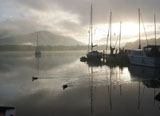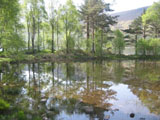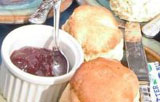|
|
Lake District Valley and Low-level WalksGummer's HowClick here for the first page of walks near Windermere
1.5 miles [2.5 km] The approach road is about seven miles from Bowness, off the road to Newby Bridge. It turns off sharply left just after Fell Foot is passed - this is the point in the journey south where the steamer pier at Lakeside is glimpsed across the lake. The road is signed Kendal. From Newby Bridge, travelling towards Bowness, the road is after one mile; the third turning on the right. There is a stone sign built into wall pointing to Kendal. The road is very steep. Near the top of the road park in one of the higher lay-bys on the left and walk up to the wooden stile over the wall, leading onto a wide path. You pass a larch plantation on the right, then after this some old larches are seen scattered about, misshapen by the prevailing wind. The path begins to steepen after a small beck. There are some good views back along the river Leven to Greenodd and beyond. If it is clear you can see Ingleton, on the Pennines, to the right. The path goes steeper and there are some rock steps. They can all be avoided in their worst places by a detour right or left. The important thing is to take your time and pick out the best route. As the summit is neared the bracken gives way to heather. There is a triangulation pillar erected by the gentlemen of the Ordnance Survey on the highest point. This is not the best viewing point though there are good views south across Morecambe Bay; in fact, if it is clear enough, you can see Blackpool Tower. The best viewpoint is some few yards away from the summit towards the lake. This is spectacular. The pier below looks quite small and the steamers like toys. Almost the whole sweep of the lake can be seen except for the last mile or so which are obscured by Claife Heights. The round fell far off to the left is Black Coombe on the Cumbrian coast. The small pointed peak to the right, and nearer, has the peculiar name of Caw. Next there is the large Coniston Old Man range with the fierce peaked crag on the left called Dow Crag which has been famous for its rock climbs since the early days of that sport. Right of that are the Langdale Fells, the Helvellyn Fells, Fairfield, and further right the High Street range. Esthwaite Water can be seen clearly. Take care on the way down, which is the same path as your route up. A Walk Up Orrest Head 1.5 miles [2.5 km] Park near the railway station. Instead of entering the station, cross the main road and look for a small turning which runs upwards to the left of the hotel. The track is tarmacked; a short way up is a footpath sign with two arms, one pointing left and one ahead. Go ahead, up a winding track up the hill. As you ascend the view opens up on the right. There is a view of the lake across the roofs of the village. This tarmac lane zig-zags for most of the way to the summit through a mixed woodland. Beyond a cottage there is an open area to the right and the tarmac gives way to a rough stone track. Presently the track breaks into three. All the ways lead to the summit, but the easiest route is the right hand one following a wall, and slanting off to the corner of another wall. Pause here and enjoy the view of the lake, backed by the fells of the Coniston Old Man range. Just across the lake are the wooded heights of Claife. Towards the right of this is a clear summit crowned by a slim cairn. This is Latterbarrow. Keeping to the right hand path beside a wall we pass through some fine beech trees. Ignore the iron gate at right and continue up towards the corner of the wall. At the wall corner bear right between the wall and a wire fence past some wooden seats. Our objective can now be seen on the grassy crag to the left - the pulpit, the summit view indicator. Continue until an iron kissing-gate is reached on the left. Go through the kissing-gate and straight ahead to the left of the tree towards the pulpit. Take care in ascending the grass as it can be slippery. Directly in front the summit of Coniston Old Man (2,631 feet) and the big shoulder to its right is Wetherlam (2,502 feet). Then comes the crinkles of Crinkle Crags, just a little to the right, and in front of the Pike o'Blisco. If the view is very clear a glimpse of the Scafells is behind, though appearing somewhat dwarfed by their distance away - about fourteen miles. Scafell Pike is the highest point in England (3,206 feet). The summit of nearer Bowfell (2,960 feet) is to the right. Esk Pike is right of this, and if visibility allows, the northern shoulder of the Scafells, Great End (2,984 feet). The familiar Langdale Pikes come next and then, behind, the long ridge of High Raise and Ullscarf. Turning right again the top of the Fairfield Horseshoe can be seen above Wansfell. Right again to the head of Troutbeck is the High Street range. Right again, to look easterly, there are the Yorkshire fells with the flat top of Ingleborough very prominent. To return, go back to the kissing-gate, but this time instead of going through the beech trees take the path going fairly steeply down beside a wall. This wall marks the boundary of the wood and is followed all the way back. The path winds gradually left, sometimes between two mossy walls, and eventually comes out at the signpost seen on the way up - only this time from the other side.
|
|
|
|
|



